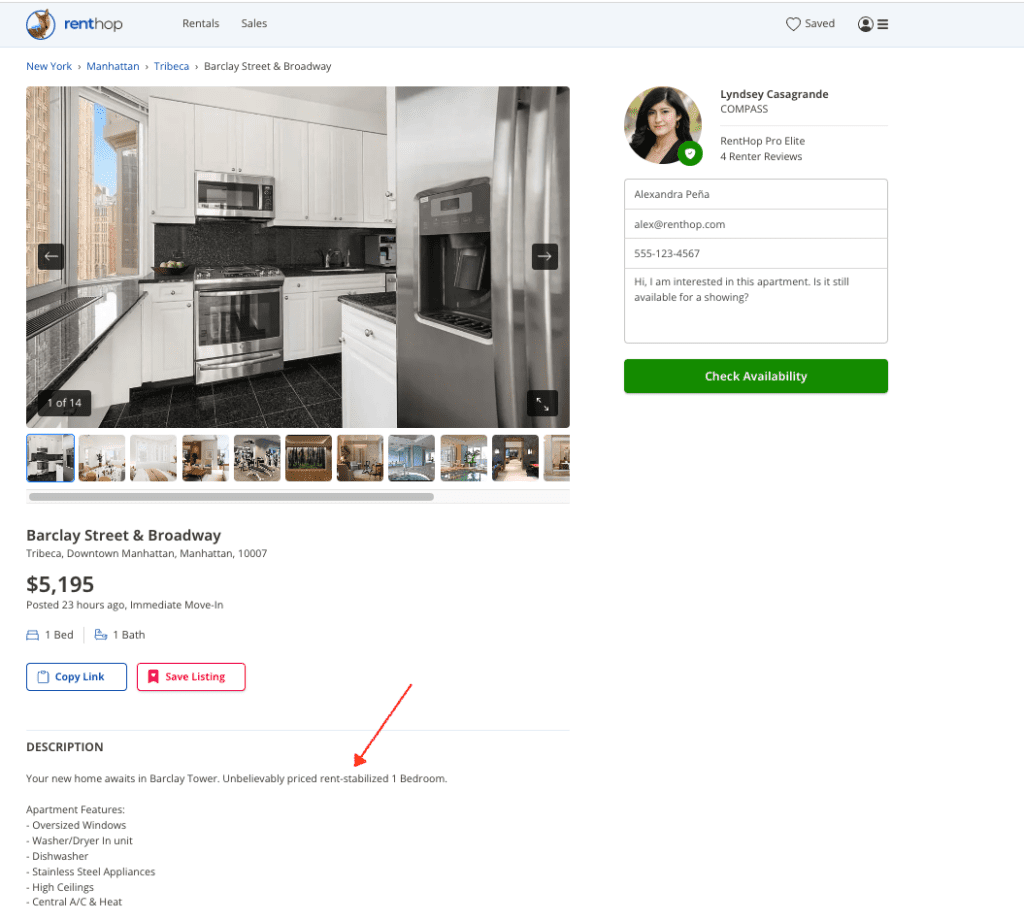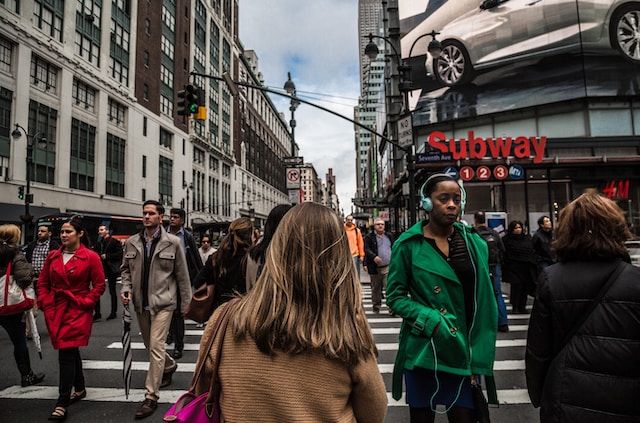Rising rents in NYC make the prospect of finding a rent-controlled or rent-stabilized apartment more appealing than ever. These elusive units charge a fraction of the market rate, saving renters thousands of dollars in the long run. They’re rumored to exist across the five boroughs, particularly in older buildings. Rumor also has it they charge as little as $700 a month, with spacious floor plans in great locations.
But rumors don’t always reflect the reality of rent-controlled versus rent-stabilized apartments in NYC. Yes, they exist, though the odds of snagging one make it likelier to win the Powerball. That they go for peanuts is another common misconception.
The reality is that the rent for a rent-stabilized unit can range from around $1,000 to upwards of $3,000, depending on the building’s age, whether it has any tax abatements, and other statutory rules.
So, how does one go about finding a rent-regulated apartment in New York City? We’ll get to that in a moment.
First, let’s clear up the confusion between the terms “rent-regulated,” “rent-controlled,” and “rent-stabilized,” as well as explain how they came to be.
What Are Rent-Regulated Apartments, and Where Did They Come From?
“Rent-regulated” is an umbrella term that refers to both rent-controlled and rent-stabilized apartments, similar to how “tubers” may refer to both Idaho potatoes and sweet potatoes.
What Is A Rent-Controlled Apartment?
Rent-controlled units are perhaps the most enigmatic of the two. For starters, they’re among the oldest type of rental dwellings in NYC, having been established in 1943. In November of that year, the city’s Office of Price Administration (OPA) froze rental rates in New York at the same level they were on March 1st, 1943. The OPA emerged from then-U.S. President Franklin D. Roosevelt’s Emergency Price Control Act, which sought to prevent inflation during World War II. The price administration office has since dissolved.
Rent-controlled apartments must be continuously occupied since July 1, 1971, but if the tenant moves out or dies, another family member or person is eligible to continue the rent-controlled status if they lived there for 1-2 years prior.
In 1950, when rent-control laws were formally codified in New York State, there were approximately 2.1 million apartments in NYC that were subject to rent regulation.
In 2021, however, the city’s Housing and Vacancy Survey reported fewer than 17,000 rent-controlled units in the city.
What Is A Rent-Stabilized Apartment?
Rent-stabilized apartments, on the other hand, made up roughly one-third of the city’s rental stock, with about 1.1 million units. The Rent Stabilization Act of 1969 defined them as apartments in buildings with six or more units built before January 1st, 1974. Tenants who took occupancy after June 30th, 1971, are considered rent-stabilized. Those who maintained occupancy before July 1st, 1971, are generally considered rent-controlled.
While rent-stabilized apartments are typically found in buildings built after 1947 and before 1974, there are some exceptions for newer buildings that have J-51, 421-a, and 421-g tax benefits. Developers who renovate existing buildings and/or designate 20% of new-construction units as rent-stabilized may qualify for these benefits. The period for these incentives lasts roughly 10 to 35 years, depending on the building’s qualifying status.
What Are the Benefits of Rent-Regulated Apartments?
Besides paying below-market rent, one of the key benefits of living in a rent-controlled or rent-stabilized apartment is that the landlord can’t increase the rent beyond a marginal percentage, as set by the New York City Rent Guidelines Board.
Each year, the board votes on a percentage increase cap for one- and two-year leases that fall under rent stabilization laws. On June 21st, 2022, the board voted to cap rent increases at 3.25% for one-year leases and 5% for two-year leases signed between October 1st, 2022, and September 30th, 2023.
Another benefit is that landlords can’t evict tenants from rent-regulated apartments without a compelling reason, such as nonpayment of rent or violating the lease terms. Stabilized units are also guaranteed a renewal offer with one- and two-year terms, depending on the renter’s preference.
By contrast, tenants in rent-controlled apartments are considered “statutory,” meaning they’re still protected by the Emergency Housing Rent Control Law of 1946. This law doesn’t require landlords to offer renewal leases and makes it even harder for them to file eviction proceedings.
How Much Do Rent-Regulated Apartments Cost in NYC?
Rent-controlled apartments typically have the lowest rental rates in NYC. A 2022 article by The Guardian found that long-term renters in sought-after areas of Manhattan (think: East, West, and Greenwich villages) were paying as little as $820 a month for their rent-controlled units. Most of these were unrenovated and came with little-to-no amenities. But that didn’t stop their leaseholders from staying put since the ’60s and early ‘70s, if not before.
Rent-stabilized apartments, on the other hand, can range from around $1,000 to a max of $2,700 per month, unless the building was built after 1974 and has the 421-a tax abatement. In that case, tenants may sign a rent-stabilized lease with a rent amount that reflects the current market rate.
In other words, rent-stabilized apartments in NYC can cost more than $2,700 a month, so tenants need to do their research and understand what they’re signing before they move in.
The good news is that market-rate units that offer stabilized leases enjoy regulations enforced by the NYS Division of Housing and Community Renewal (DHCR). These include a renewal offer if the resident is in good standing and an annual rent increase percentage cap.
Do I Have a Shot at Finding a Rent-Controlled Apartment?
Given the scarcity of rent-controlled units in NYC, it’s highly unlikely that a new renter without ties to the unit’s original occupant will find one.
The same can be said for rent-stabilized units, except that these are not as rare. After all, rent-stabilized apartments make up roughly 30% of rental units in NYC.
But winning the “Powerball” of affordable housing in the Big Apple isn’t impossible. Those with family members who already live in stabilized units can benefit from the DHCR’s Succession Rights. The law states that family members have the right to a renewal lease or protection from eviction if they resided with the tenant as a primary residence for two years immediately before the permanent departure from the apartment by the original tenant.
A family member can be a spouse, stepson, father-in-law, or anyone else who can prove an “emotional and financial commitment and interdependence between such person(s) and the tenant.” This means a roommate may be eligible if they can prove a close relationship with the leaseholder.
How Can I Tell If an Apartment Is Rent-Stabilized?
We know that rent-stabilized apartments are more commonly found in buildings built before 1974 and that they’re probably not as renovated as newer, fair-market units.
But how can a prospective renter be sure? According to the NYC Rent Guidelines Board, the only way to know for sure is to contact the Office of Rent Administration.

This can be useful when dealing with a landlord who either refuses to confirm whether the apartment is rent-stabilized or claims it isn’t when in fact it is.
It can also clear up any confusion about the units in older buildings that may appear to be stabilized because they haven’t undergone a complete renovation over the years but are, in fact, fair-market or market-rate units.
How To Find a Rent-Stabilized Apartment in NYC
There are several ways prospective renters can hunt for rent-regulated apartments in NYC. The first is to run a rent-regulated building search on the DHCR’s website. Before that, however, renters should take note of the county names and zip codes they’re interested in and narrow their search to those areas. This can save them a lot of time, especially if they’re looking for rent-stabilized units in the highly competitive Brooklyn and Manhattan markets.
Another way to find rent-stabilized apartments in NYC is by checking NYC Housing Connect. This website allows prospective renters to apply for lottery-based affordable housing based on their household count and income levels. The lottery usually precludes applicants who earn more than 80% of the Area Median Income (AMI) for their area, but this varies from building to building. It’s also important to note that these rent-regulated units are in high demand, with long waiting lists and thousands of applicants vying for a single spot.
Lastly, renters can try their luck with online rental platforms. Typing in “rent-stabilized” or “rent-regulated” into the search engine might yield some promising results. When reaching out to the landlord or listing agent, it’s important to ask what type of lease they’re offering and any potential limitations or benefits that come with it.
Is it possible to find a rent-stabilized or rent-controlled apartment in NYC?
Although it may be difficult, it is not impossible to find rent-stabilized and rent-controlled apartments in NYC.
Thankfully, the city has passed numerous laws to protect rent-regulated tenants from eviction and provide some rights for family members of current leaseholders. Additionally, landmark decisions like the Housing Stability and Tenant Protection Act of 2019 prevent landlords from deregulating newly vacated units or charging more than 20% upon vacancy.
By utilizing the DHCR website for building searches, Housing Connect for affordable housing lotteries, and online rental platforms for rent-stabilized units, there’s yet hope for prospective renters who want to live affordably in NYC. Word-of-mouth can also be a powerful tool in the search, so New Yorkers who are in it for the long haul should keep their eyes and ears open.
Good luck!
Ivan Suazo is a copywriter and SEO blogger with over ten years of experience in the real estate industry. He's also the founder of a wellness blog, QWERTYdelight.com, and writes sleep stories for the Slumber App.



